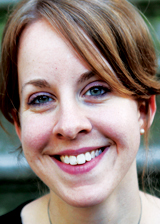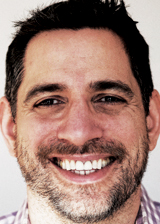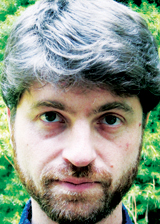lives
THREEPROFILES |
In this issue we visit three people whose journeys towards Jewish expression and involvement — whether through food, spirituality or language — took unexpected and exciting turns.by BATYA UNGAR-SARGON |

|
LEAH KOENIGThe Story Behind the FoodF or Leah Koenig, food and cookbook writer, Jewish food is a global cuisine, “because there are Jews everywhere,” she said recently at a Brooklyn café. “Historically, Jews were indigenous, tribal, nomadic and then agricultural,” she explained, citing the multitude of Talmudic laws about agriculture. “It’s not a leap to think of Jews as a land driven people, even though we’re a diasporic people.” Koenig grew up in Oak Park, Chicago, in a multi-faith household — her mother is Jewish, and her father, who recently passed away, was not. It was a pluralistic upbringing — Koenig was batmitzvahed, but spent Christmas with an older sister. It was also a family in which faith and social justice were intertwined. Her father’s side are United Church of Christ — “like the Reform movement of the Christians — very social-justice oriented,” Koenig said. ‘‘Humans put on this earth to till and to tend, rather than to have dominion over it; that’s where it starts for me.’’As a girl, Jewish life was less compelling to her; Koenig was much more focused on being an environmentalist. Her “aha moment” would come in college, first at University of Oregon and then at Middlebury, where she took classes on Judaism and Ecology. “That was the beginning of my being interested in Jewish life on a personal as well as an academic level,” she remembered. Sustainability is a Jewish value, Koenig said. “For me, when I was studying it academically, I was always really focused on how there’s two different creation stories at the beginning of Bereishit,” she explained. “One is very much about God creating the world for humans, and one is creating humans in partnership with the world.” Of the two competing narratives, one held significant swag for Koenig: “humans put on this earth to till and to tend, rather than to have dominion over it; that’s where it starts for me.” Koenig got a job working at Hazon and moved to New York. “Then I was living in Brooklyn, doing the Shabbat dinner thing, starting to build this community of young environmentally minded or Jewishly minded folks,” she said. She met her husband, Yoshie Fructer, a professional musician, who came from an Orthodox background, and together, through negotiations, the couple came to an agreement about the level of religious observance that would suit them. “It was sort of like, I want to be with you, you want to be with me, how can we make it work,” Koenig recalled. Today, they have a “Shabbat practice” and a son. In 2009, Koenig left Hazon to pursue freelance writing fulltime. “I didn’t think I’d focus on Jewish food, but it turns out, that’s what I’m most passionate about,” she said. “Whenever I would think about story ideas, that is where my expertise lies.” This passion and expertise led to cookbooks, first the Hadassah Everyday Cookbook (Rizzoli/Universe, 2011) and then Modern Jewish Cooking (Chronicle Books, 2015). “I’m definitely a home cook,” Koenig says. “And more to the point, I’m a food writer who cooks. My interest is the story behind the food. My starting point is the story — always.” Koenig’s hope is for Modern Jewish Cooking to represent a historical snapshot of “how the Jewish community eats today, and how we celebrate, and how we bring ourselves to the table,” she said. Today’s Jewish culinary experience has an eye towards sustain-ability and an eye towards the global world in terms of flavor influences. “There’s a delicate balance between tradition and innovation that I seek in my daily life as a cook, and I’m just one of many people doing that.” That balance is all over the cookbook, with updated traditional recipes, some of which have a surprising, playful, even perverse twist, like a savory babka, or sweet potato and parmesan hamentashen. “My grandmother would have recognized them, but someone today would find them interesting,” she said. “A savory hamentashen is just a moment of, Hey food is fun! And an experiment! The way we create tradition is by giving ourselves the freedom to play around a little.” Of course, it’s possible to go too far, Koenig says, citing bacon-laced matzoh balls, for example, which are going in for the shock factor. It’s about having respect for the tradition, and an authenticity in your choices when you experiment. “Now is one of the most exciting times to eat Jewish food,” Koenig said. ■ |

|
RABBI DAVID INGBERPersonal RenewalR abbi David Ingber was voted “most likely to frum out” in high school. His journey did indeed lead him through an ultra-Orthodox phase, and then through a completely secular one, before he founded Romemu, a “post-denominational, post-modern, Hassidic, fully egalitarian, embodied, politically progressive” community on the Upper West Side. Ingber grew up on Long Island, a twin and the youngest >son of “classically Ashkenazi Jews,” as he put it. “It was a very suburban, typically American, Jewish experience,” Ingber says. ‘‘I had an allergic reaction to Judaism in those years,’’ Ingber says. ‘‘I would see people walking to shul on Friday night when I was serving spaghetti ragù.’’But the young Ingber didn’t exactly fit in. “I was extremely intense about everything,” he remembers. The goalie in hockey and in soccer, Ingber would self-impose “speech fasts for two days before the game,” he recalled. “I would carry a puck and stare at it for an hour every day.” In high school he got into body-building, and he was very extreme about that too. On high-school religious retreats, he would resist the teachers the first day, but by the second day he would be leading the songs. “By the third day I’d be shomer negiah for three months,” he remembered with a chuckle. The way Ingber tells it, he had the soul of a “super sensitive kid” who “looked like a jock.” “The difference between how I was perceived and what I was was very painful,” he recalled. “I chose the wrong guys to hang out with,” he went on. “I read Harold Kushner at 15, and I remember holding court, talking about it, having deep conversations, but I was always in the jock room.” After high school he went to Israel for a gap year, where he fell under the sway of an eccentric scholar who had locked himself in a bomb shelter to complete his study of the Talmud. “He introduced me to a Judaism that had been all around me growing up but I had never been aware of,” Ingber said. “It opened me up to all this longing I had as a kid.” Learning with this mentor led Ingber down a “two year intensive religious conversion where I became the terror of every Modern Orthodox parent’s nightmare: I became more religious than them.” He stayed that way for five years, returning to New York and studying at an ultra-Orthodox Yeshiva. “I was in love with God, in a way that was intense and nourishing but also scary,” he remembered. And then, one day, he looked in a mirror and saw his long payos and big black hat, and instead of himself, he saw a caricature. It was the beginning of major philosophical doubts. “I felt that I was depressed, and I believed my depression was because of Judaism,” he said. “In order to heal myself, I needed to go back to the place of being alive, dynamic, myself at 18.” Ingber started listening to the radio again and watching TV. He went dancing again. He moved in with his brother and started working in restaurants in Manhattan, which he loved for the freedom it afforded him and the personal interactions. Meanwhile, “I had an allergic reaction to Judaism in those years,” Ingber says. “I would see people walking to shul on Friday night when I was serving spaghetti ragù.” But something in him remained unrealized in those years. “I felt very called, and I didn’t know the way back. I didn’t know how to move forward,” he says. “I was waiting tables, surrounded by people who didn’t have the gifts I was given.” Ingber moved to Israel, and spent a year there teaching Pilates. It was beautiful, he says, but suddenly, he was miserable again. He would constantly think, “Is this what you want me to do, God? Crack people’s backs?” He started keeping kosher again and putting on tefilln every day, “much to the chagrin of my totally secular Israeli girlfriend.” In 2004, he met Rabbi Zalman Schachter-Shalomi, the then-94-year-old founder of the Jewish Renewal movement, and it was then that his path became clear. “The things that felt to me like questions weren’t questions within [Schachter-Shalomi] anymore,” he recalled. “They were residing comfortably within him. He was observing Judaism because he loved Judaism. He would say it doesn’t matter if it’s true, it’s beautiful, it’s transformative, and it’s ours.” Schachter-Shalomi gave Ingber smicha, and in March 2006, Ingber started Romemu, which he calls an “upgraded” and “evolved” Judaism, an American form of Hassidic expression for the 21st Century, and “part of a solution to a problem our traditions have partly created. It’s a renewal of Judaism that unaffiliated Jews and others are yearning for.” If anyone would know, it’s David Ingber. ■ |

|
ROSS PERLINTowards a Multilingual FutureL ike many Jewish visionaries, Ross Perlin came to appreciate his tribal culture from afar. The Assistant Director of the Endangered Language Alliance, Perlin grew up Reform in New York, attended boarding school in Massachusetts and went on to Stanford in California. “I wasn’t engaged with Jewish studies or Jewish life, though I felt myself to be Jewish, culturally and historically,” he recalled recently. After college, he moved to China to study comparative ancient philosophy and Chinese, in the hopes of being able to communicate with a billion people. It was there that Perlin attended a talk by an eminent Chinese linguist, who told the audience and a surprised Perlin that of the 200 languages spoken across China, most would disappear in our lifetime. “I had no idea that across the world, there were some 7,000 languages,” Perlin said, “and half will disappear within the next century. As a lover of languages and as somebody who cared about culture and minority cultures and history, I got into this whole issue of endangered languages.” When a language disappears, an entire worldview goes under, an entire repository of history, culture, knowledge, local knowledge of a place.’He spent the next three years working as a field linguist on a cluster of endangered languages spoken on the Chinese-Burmese border. He would sit with the elders of these communities and ask them to sing their songs so he could record them, and sometimes they would ask Perlin, “What are your songs?” “I was forced to ask myself that question and think about the question of my own ethno-linguistic tradition and heritage. So I became involved with Yiddish.” Perlin moved back to New York, and in 2010, the Endangered Language Alliance was formed. He came to realize that Yiddish, while in certain ways endangered, does have a strong future, both through the Hassidic communities for whom it is mother tongue and through a small core of Yiddishists, academics and enthusiasts. Plus, it has a huge written heritage that’s been preserved. “What I hadn’t understood until I got here was that there were all these other Jewish languages that were fast disappearing and in much worse shape than Yiddish has ever been,” Perlin said. New York alone has several dozen Jewish languages, like Jihuri, a Jewish language spoken by the mountain Jews of Dagestan and Azerbaijan, and which is still spoken in a synagogue on Ocean Parkway; and Bukhari, spoken by the Bukharian Jews; and the Judeo Median languages of Iranian Jews who never moved to Tehran where they would have traded their dialect for Persian. It’s not just Jews, either. There are up to 800 languages spoken in the New York area alone. At the Endangered Language Alliance, a non-profit operating on a shoestring budget that relies on donated space and a lot of volunteer work, Perlin documents these and other languages. “We create and present a rich record of these languages while we can,” Perlin said. It’s important work, Perlin explained. “When a language disappears, an entire worldview goes under, an entire repository of history, culture, knowledge, local knowledge of a place,” he explained. Plus, languages don’t die natural deaths. “It’s generally the outcome of power struggles and massive shifts that are taking place,” he went on. Take Jewish history for instance. “The Jewish communities we’ve worked with, while very deeply grateful that they have landed in the U.S. or Israel, have experienced a profound sense of dislocation nonetheless and have basically been uprooted, in some cases multiple times throughout the 20th Century, because of anti-Semitism, war, genocide and various forms of dispossession,” Perlin explained. But Perlin is interested in going beyond pathos. In the beginning of the 20th Century, Jews spoke dozens of languages, with ties to many cultures and numerous ways of expressing themselves. Now, Jewish life is converging on English and Hebrew and a few other languages. “But what if we could have a much more multilingual future?” Perlin wonders. To that end, the Endangered Language Alliance tries to bring its work to a wider Jewish public through talks and a tour of Brooklyn’s Jewish languages. “Most Jewish languages are represented to some extent in the five boroughs,” Perlin says. “There still is this diversity that’s hard to appreciate just walking around. You have to know about it and listen for it and it is unfortunately vanishing.” ■ Batya Ungar-Sargon is a freelance writer living in Brooklyn. |
| PREVIOUS ARTICLE | NEXT ARTICLE |